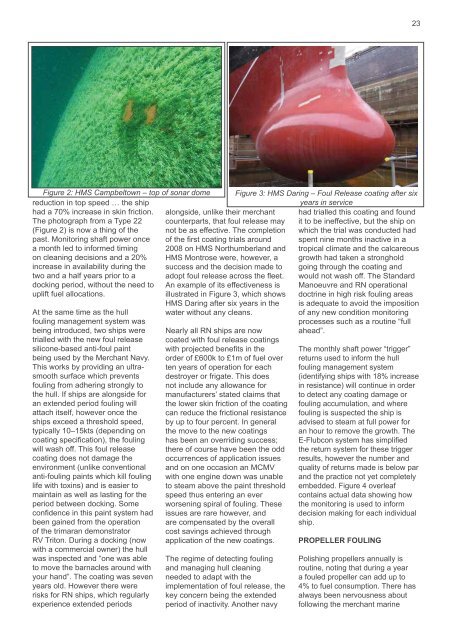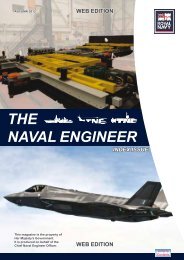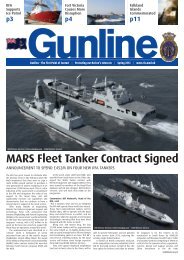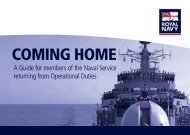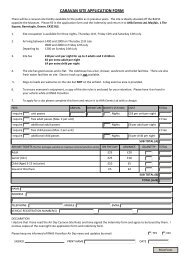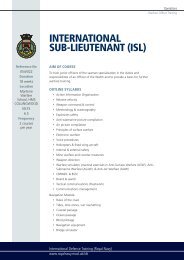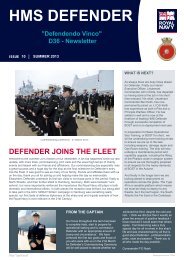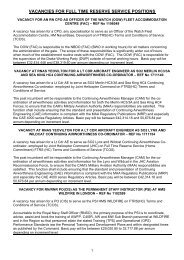THE NAVAL ENGINEER
THE NAVAL ENGINEER
THE NAVAL ENGINEER
You also want an ePaper? Increase the reach of your titles
YUMPU automatically turns print PDFs into web optimized ePapers that Google loves.
23<br />
Figure 2: HMS Campbeltown – top of sonar dome<br />
reduction in top speed … the ship<br />
had a 70% increase in skin friction.<br />
The photograph from a Type 22<br />
(Figure 2) is now a thing of the<br />
past. Monitoring shaft power once<br />
a month led to informed timing<br />
on cleaning decisions and a 20%<br />
increase in availability during the<br />
two and a half years prior to a<br />
docking period, without the need to<br />
uplift fuel allocations.<br />
At the same time as the hull<br />
fouling management system was<br />
being introduced, two ships were<br />
trialled with the new foul release<br />
silicone-based anti-foul paint<br />
being used by the Merchant Navy.<br />
This works by providing an ultrasmooth<br />
surface which prevents<br />
fouling from adhering strongly to<br />
the hull. If ships are alongside for<br />
an extended period fouling will<br />
attach itself, however once the<br />
ships exceed a threshold speed,<br />
typically 10–15kts (depending on<br />
coating specification), the fouling<br />
will wash off. This foul release<br />
coating does not damage the<br />
environment (unlike conventional<br />
anti-fouling paints which kill fouling<br />
life with toxins) and is easier to<br />
maintain as well as lasting for the<br />
period between docking. Some<br />
confidence in this paint system had<br />
been gained from the operation<br />
of the trimaran demonstrator<br />
RV Triton. During a docking (now<br />
with a commercial owner) the hull<br />
was inspected and “one was able<br />
to move the barnacles around with<br />
your hand”. The coating was seven<br />
years old. However there were<br />
risks for RN ships, which regularly<br />
experience extended periods<br />
alongside, unlike their merchant<br />
counterparts, that foul release may<br />
not be as effective. The completion<br />
of the first coating trials around<br />
2008 on HMS Northumberland and<br />
HMS Montrose were, however, a<br />
success and the decision made to<br />
adopt foul release across the fleet.<br />
An example of its effectiveness is<br />
illustrated in Figure 3, which shows<br />
HMS Daring after six years in the<br />
water without any cleans.<br />
Nearly all RN ships are now<br />
coated with foul release coatings<br />
with projected benefits in the<br />
order of £600k to £1m of fuel over<br />
ten years of operation for each<br />
destroyer or frigate. This does<br />
not include any allowance for<br />
manufacturers’ stated claims that<br />
the lower skin friction of the coating<br />
can reduce the frictional resistance<br />
by up to four percent. In general<br />
the move to the new coatings<br />
has been an overriding success;<br />
there of course have been the odd<br />
occurrences of application issues<br />
and on one occasion an MCMV<br />
with one engine down was unable<br />
to steam above the paint threshold<br />
speed thus entering an ever<br />
worsening spiral of fouling. These<br />
issues are rare however, and<br />
are compensated by the overall<br />
cost savings achieved through<br />
application of the new coatings.<br />
The regime of detecting fouling<br />
and managing hull cleaning<br />
needed to adapt with the<br />
implementation of foul release, the<br />
key concern being the extended<br />
period of inactivity. Another navy<br />
Figure 3: HMS Daring – Foul Release coating after six<br />
years in service<br />
had trialled this coating and found<br />
it to be ineffective, but the ship on<br />
which the trial was conducted had<br />
spent nine months inactive in a<br />
tropical climate and the calcareous<br />
growth had taken a stronghold<br />
going through the coating and<br />
would not wash off. The Standard<br />
Manoeuvre and RN operational<br />
doctrine in high risk fouling areas<br />
is adequate to avoid the imposition<br />
of any new condition monitoring<br />
processes such as a routine “full<br />
ahead”.<br />
The monthly shaft power “trigger”<br />
returns used to inform the hull<br />
fouling management system<br />
(identifying ships with 18% increase<br />
in resistance) will continue in order<br />
to detect any coating damage or<br />
fouling accumulation, and where<br />
fouling is suspected the ship is<br />
advised to steam at full power for<br />
an hour to remove the growth. The<br />
E-Flubcon system has simplified<br />
the return system for these trigger<br />
results, however the number and<br />
quality of returns made is below par<br />
and the practice not yet completely<br />
embedded. Figure 4 overleaf<br />
contains actual data showing how<br />
the monitoring is used to inform<br />
decision making for each individual<br />
ship.<br />
Propeller Fouling<br />
Polishing propellers annually is<br />
routine, noting that during a year<br />
a fouled propeller can add up to<br />
4% to fuel consumption. There has<br />
always been nervousness about<br />
following the merchant marine


